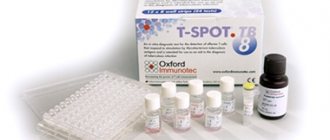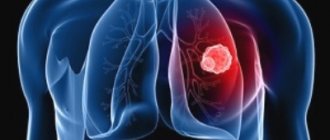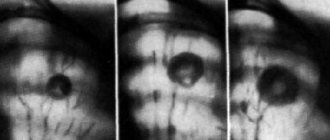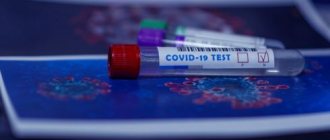Detailed description of the study
The study aims to diagnose respiratory tuberculosis, a multisystem disease with multiple manifestations that is the most common cause of infectious disease mortality worldwide. According to WHO, in 2015 there were 1.4 million deaths from tuberculosis, of which 0.4 million people had HIV.
Russia is one of the countries with the highest prevalence of tuberculosis, although over the past 10 years a positive trend has been observed in this direction: the number of new cases of infection and the proportion of carriers out of the total number of patients are decreasing. As a rule, this disease affects the lungs (85% of cases), but can also affect other organs, including bones. Sources of infection are sick people with an open form of the disease - releasing the pathogen into the environment with saliva.
Symptoms of the disease are:
- Weight loss/anorexia;
- Loss of appetite;
- Profuse sweating at night;
- Heat;
- General weakness.
If we are talking about the pulmonary form of the disease, symptoms may include:
- Cough;
- Hemoptysis (coughing up blood);
- Chest pain.
In the extrapulmonary form, symptoms will depend on the area of the lesion.
Mycobacterium tuberculosis complex is the common name for closely related bacteria that cause tuberculosis. They have many pathogenicity factors that allow them to survive for a long time in the environment and evade the immune response. Mycobacterium tuberculosis is an intracellular parasite, thus, being absorbed by the cells of the immune system, the pathogen inactivates the enzymes of these cells, remaining viable. Thanks to these properties, Mycobacterium tuberculosis is a rather dangerous disease, especially for people with weakened immune systems. Infection usually occurs through airborne droplets when an infected person sneezes or coughs; in rare cases, even a conversation with a sick person is enough for infection. Also, tuberculosis can be transmitted even from a pregnant woman to her fetus while still in the womb.
Polymerase chain reaction (PCR) is a research method that allows you to detect pathogen DNA in biomaterial even in small quantities. PCR for M. Tuberculosis, according to international clinical guidelines, is not the standard for diagnosing this disease. This test is used as an additional test. “Gold standard”: Mantoux test, T-SPOT, Diaskin or Quantiferon test.
Mycobacterium tuberculosis, DNA [real-time PCR]
A study to identify the causative agent of tuberculosis (Mycobacterium tuberculosis), during which the genetic material (DNA) of the mycobacterium in a sample of biomaterial is determined using the real-time polymerase chain reaction (RT-PCR) method.
Synonyms Russian
Tuberculosis, Mycobacterium tuberculosis, Koch's bacillus.
English synonyms
Tuberculosis, Tubercle bacillus, Koch's bacillus.
Research method
Real-time polymerase chain reaction.
What biomaterial can be used for research?
Biopsy, venous blood, cerebrospinal fluid, sputum, pleural fluid, the first portion of morning urine, ejaculate.
General information about the study
Tuberculosis (from the Latin tuberculum - “tubercle”) is an infectious disease of humans and animals, transmitted primarily by airborne droplets. The risk of infection increases due to immune suppression caused by HIV/AIDS, diabetes, kidney disease, organ transplantation and use of immunosuppressive drugs, pregnancy, and aging. In addition, those who come into contact with tuberculosis patients, as well as children under 5 years of age after a tuberculin test, are most susceptible to it. The most vulnerable groups of the population include homeless people, prisoners, migrants from countries with a high incidence of tuberculosis, drug users, and the elderly.
For this study, we use a test system based on the detection of genomic DNA of the tuberculosis pathogen using polymerase chain reaction (PCR) in real time (real-time PCR). In modern diagnostics, this is one of the fastest, most universal and highly sensitive methods.
Standard methods for detecting Mycobacterium tuberculosis are based on growing pathogenic microorganisms in a nutrient medium. Difficulties are associated with the low growth rate of Mycobacterium tuberculosis colonies - it is necessary to wait up to 1.5 months after taking the material.
Molecular biological methods based on the detection of the genetic material of Mycobacterium tuberculosis have high sensitivity and specificity. Their most important advantage is the high speed of obtaining results. The use of real-time PCR makes it possible to identify the causative agent of tuberculosis already on the day of receiving a clinical sample.
Bacteremia (mycobacteria entering the patient’s blood) can occur in the early stages of tuberculosis infection, as well as with the development of generalized or extrapulmonary tuberculosis. It is dangerous because the immune response to bacteria will cause sepsis and septic shock, which can lead to death. The risk of developing generalized tuberculosis is highest in patients with late-stage HIV, in those who interrupted anti-tuberculosis therapy, and in those who did not seek medical help in time when symptoms of tuberculosis appeared.
Diagnosis of tuberculosis in HIV-infected people is difficult due to the immunosuppressed state of the body, which often manifests itself in false-negative results of tuberculin reactions and microbiological tests. In this regard, testing for Mycobacterium tuberculosis using real-time PCR is of great importance.
What is the research used for?
- To diagnose pulmonary tuberculosis (in particular, its generalized and extrapulmonary forms associated with bacteremia), and monitor its treatment.
When is the study scheduled?
- If extrapulmonary tuberculosis is suspected.
- With symptoms of bacteremia against the background of tuberculosis infection: elevated body temperature, sweating, etc. (with a small amount of bacteria in the blood, bacteremia may be asymptomatic).
- If the patient has had prolonged contact with a patient with tuberculosis.
- In case of an abnormal reaction to a tuberculin test in children.
- When a patient has HIV infection.
What do the results mean?
Reference values: negative.
Positive result
- Presence of a pathogen in the biomaterial under study. This usually occurs when TB is active and requires treatment. The detection of a large number of mycobacteria most often indicates an extrapulmonary form of tuberculosis or generalization of the infection.
Negative result
- The causative agent of tuberculosis has not been identified. There is no bacteremia.
What can influence the result?
Effective anti-tuberculosis therapy eventually leads to the disappearance of mycobacteria in clinical material.
Important Notes
- To prescribe the correct treatment regimen when tuberculosis is detected in a patient, it is necessary to test the sensitivity of mycobacteria to anti-tuberculosis drugs.
Also recommended
- Mycobacterium tuberculosis, antibodies
- Mycobacterium tuberculosis complex, DNA [real-time PCR]
Who orders the study?
General practitioner, therapist, phthisiatrician, urologist, gynecologist, infectious disease specialist.
References
- Skornyakov, S.N., Shulgina, M.V., Ariel, B.M. and others. Clinical guidelines for the etiological diagnosis of tuberculosis, 2014. - pp. 39-58.
- National Association of Phthisiatricians: Clinical guidelines for the diagnosis and treatment of respiratory tuberculosis in adults, 2013. - 38 p.
- Chernousova, L.N., Sevastyanova, E.V., Larionova, E.E. and others. Federal clinical recommendations for the organization and conduct of microbiological and molecular genetic diagnostics of tuberculosis, 2014. - 36 p.
- Tuberculosis in the Russian Federation 2011. Analytical review of statistical indicators used in the Russian Federation and in the world. - M., 2003.
- World health organization: website / WHO: The Stop TB Strategy, 2021, - URL: https://www.who.int/tb/strategy/stop_tb_strategy/en/National Center for
- National Center for HIV/AIDS, Viral Hepatitis, STD, and TB Prevention. Division of Tuberculosis Elimination.Tuberculosis Disease FactSheets: website, 2021. - URL: https://www.cdc.gov/tb/publications/factsheets/testing/diagnosis.htm
- Peter, J., Green, C., Hoelscher, M. et al. Urine for the diagnosis of tuberculosis: current approaches, clinical applicability, and new developments. Curr Opin Pulm Med., 2010. - Vol.16(3). — P. 262-270.
Mycobacterium tuberculosis complex, DNA [real-time PCR]
A molecular genetic study that makes it possible to determine the presence of DNA from tuberculosis pathogens – M. tuberculosis and M. bovis – in the biomaterial under study.
Synonyms Russian
Pathogens of tuberculosis, DNA [real-time PCR] (urine, endometrial cells of the uterus, ejaculate, prostate secretions).
English synonyms
Mycobacterium tuberculosis complex, DNA.
Research method
Real-time polymerase chain reaction.
What is this analysis used for?
For diagnosing tuberculosis of the genitourinary system and monitoring its treatment.
When is the test scheduled?
If tuberculosis is suspected.
What biomaterial can be used for research?
Endometrial cells of the uterus, the first portion of morning urine, urogenital smear (with prostate secretions), ejaculate.
How to properly prepare for research?
- No preparation required.
General information about the study
Tuberculosis is still the most common cause of death from infectious diseases in adults. It is caused by human (M. tuberculosis) and bovine (M. bovis) types of mycobacteria. A distinctive feature of these bacteria is the resistance of their cell wall to acids, which is why they are called acid-resistant. Infection with Mycobacterium tuberculosis occurs, as a rule, by airborne droplets, and Mycobacterium bovis - through nutrition (through food products, including milk), infection is possible by contact (through the wound surface) and in utero (from a mother with tuberculosis to the fetus).
During primary infection, clinical symptoms are usually absent. As the disease progresses, fatigue, night sweats and fever, cough with sputum, and weight loss appear. In approximately 10% of cases, an active form of tuberculosis is observed, the risk of development of which is highest in cases of weakened immunity, including HIV infection, diabetes mellitus, end-stage renal failure, malignant tumors, etc.
The fastest and most sensitive method (sensitivity - 95%) for detecting tuberculosis is the polymerase chain reaction. Its principle is based on the amplification (manifold increase in copy number) of DNA sections specific for tuberculosis pathogens.
What is the research used for?
- For the diagnosis of tuberculosis - the genitourinary system, as well as pulmonary forms.
- To assess the effectiveness of ongoing anti-tuberculosis therapy.
- For early detection of relapses of tuberculosis.
When is the study scheduled?
- For symptoms or radiological changes characteristic of tuberculosis.
- For infertility.
What do the results mean?
Reference values: negative.
Reasons for a positive result
- Infection with tuberculosis pathogens.
- Detection of DNA fragments of non-viable Mycobacterium tuberculosis after effective therapy (false-positive result).
Reasons for a negative result
- Lack of infection with tuberculosis pathogens (absence of tuberculosis).
- Insufficient amount of pathogen.
What can influence the result of the study?
- Previous antibacterial therapy.
- Contamination of the sample with foreign DNA molecules contributes to a false-positive result, while inhibition of the polymerase chain reaction by components of bioassays (hemoglobin, heparin, etc.) leads to a false-negative result.
Also recommended
- Mycobacterium tuberculosis, antibodies
- Complete blood count (without leukocyte formula and ESR)
- Leukocyte formula
- Erythrocyte sedimentation rate
Who orders the study?
Phthisiologist, therapist, pediatrician, general practitioner, urologist, gynecologist.
Literature
- Kishkun A. A. Guide to laboratory diagnostic methods / A. A. Kishkun. – M.: GEOTAR-Media, 2007. – 822 p.
- Fitzgerald D., Haas DW Mycobacterium tuberculosis. In: Principles and practice of infectious disease / GL Mandell, Bennett JE, Dolin R (Eds) ; 6th ed. – Churchill Livingstone, Philadelphia, PA 2005. – 2701 p.
- Slaven EM Infectious diseases. Emergency department, diagnosis & management / EM Slaven, SC Stone, FA Lopez. – McGraw-Hill's





